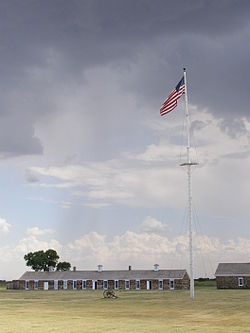Fort Larned
|
Fort Larned National Historic Site
|
|

Fort Larned Flagpole and Commissary Building
|
|
| Location | Pawnee County, Kansas, Kansas route 156, USA |
|---|---|
| Nearest city | Larned, Kansas |
| Coordinates | 38°10′59″N 99°13′05″W / 38.18306°N 99.21806°WCoordinates: 38°10′59″N 99°13′05″W / 38.18306°N 99.21806°W |
| Area | 718 acres (2.91 km²) |
| Built | 1860 |
| Architect | Quartermaster Dept., U.S. Army |
| Visitation | 31,551 (2005) |
| NRHP Reference # | 66000107 |
| Significant dates | |
| Added to NRHP | October 15, 1966 |
| Designated NHS | August 31, 1964 |
Fort Larned National Historic Site preserves Fort Larned which operated from 1859 to 1878. It is approximately 5.5 miles (8.9 km) west of Larned, Kansas, United States.
The Camp on Pawnee Fork was established on October 22, 1859 to protect traffic along the Santa Fe Trail from hostile American Indians,. It was renamed Camp Alert in 1860, as the small garrison of about 50 men had to remain constantly alert for Indians. In May 1860 it was moved upstream, 3 miles (4.8 km) 30 miles to the west up the Pawnee Fork, and by the end of the month was renamed Fort Larned. It served the same purpose as Camp Alert and as an agency for the administration of the Central Plains Indians by the Bureau of Indian Affairs under the terms of the Fort Wise Treaty of 1861. The fort's service ended as a combination of the tribes' relocation to reservations and the completion of railroads across Kansas that ended the need for the Santa Fe Trail.
Larned, Kansas and the fort that was constructed there are named in honor of Colonel Benjamin F. Larned, the paymaster general of the United States Army at the time the post was established. Larned experienced a lengthy military career, first serving as an ensign in the 21st Infantry during the War of 1812. He was promoted to captain after the defense of Fort Erie, and by 1854 Larned was a colonel and had been appointed paymaster general. Despite the town and fort bearing his name, Colonel Larned ironically never came to Kansas.
As the American government claimed vast amounts of land west of the Mississippi River, trade and commerce with the territories grew exponentially. According to one source in 1859, trade had risen $10,000,000 annually. In the Missouri Republican, it was reported that 2,300 men, 1970 wagons, 840 horses, 4,000 mules, 15,000 oxen, 73 carriages, and over 1,900 tons of freight left Missouri for New Mexico. It became apparent an additional fortification was required to protect the trade routes. Fort Larned's location was chosen by William Bent, an agent for the Upper Arkansas Indians. Bent stated, “I consider it essential to have two permanent stations for troops, one at the mouth of Pawnee Fork, and one at Big Timbers, both upon the Arkansas River....To control them (the Indians), it is essential to have among them the perpetual presence of a controlling military force.”
The fort's original structures were poorly constructed and inadequate. Built of adobe bricks, Fort Larned consisted of an officer's quarters, two combination storehouses and barracks, a guardhouse, two laundresses' quarters, and a hospital, with a bakery and meat house being later additions. After its establishment, nearby Plains Indians began to respect the trail commerce. In August, 1861, Colonel Leavenworth, reporting from Fort Larned, stated the Indians had left the Santa Fe trail area and there was no apprehension of any hostilities.
...
Wikipedia


